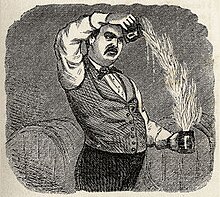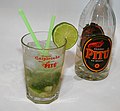Signature drink

A signature drink (from English signature = signature, as adjective : characteristic, drink = drink) is a drink that, due to its high recognition value, is used as a figurehead and for advertising purposes for a brand , a product, a bar , a restaurant , a person, a Location, region or event is used. These are often alcoholic cocktails or other mixed drinks.
The equivalent of the term signature drink for food is signature dish .
use
In German-speaking countries, the terms signature drink and signature cocktail are common, especially in connection with marketing activities in the catering and spirits industry. In the Anglo-Saxon region, the meaning is a little wider: Here, “signature drink” can only be understood in the sense of “typical drink” or “favorite drink” or it can stand for a special selection of drinks in restaurants or at events. In the United States , for example, it is popular to have one or more signature drinks put together for a wedding.
Examples
Many spirits manufacturers advertise signature drinks with special ingredients to promote sales of their products. A signature drink is “the so-called 'visible signature' that a spirit or other drink leaves in the bar,” says Helmut Adam, editor of Mixology magazine , and mentions the long drinks Licor 43 with milk , dark , as successful examples in German-speaking countries 'n Stormy (Gosling's Black Seal Rum with Ginger Beer ) or Hendrick's Tonic ( Gin Tonic with Hendrick’s Gin and cucumber slice). Further examples are the Pimm's Cup, popular especially in Great Britain since the end of the 19th century, as a signature drink for the Pimm's No. 1 and the Moscow Mule cocktail , which was originally created to promote sales of Smirnoff vodka and ginger beer. The spread of the Brazilian cocktail Caipirinha in Germany since the 1980s is closely linked to its use as a signature drink for the Cachaça brand Pitú . Since around 2005, the Campari Group has been very successful in establishing a Spritz variant ( Aperol Spritz ) as the signature drink of the Aperol liqueur internationally, according to Mixology, a “dream come true in the fairyland of the beverage industry”. The long drink Paloma ( tequila , grapefruit lemonade, some lime juice and salt) was already widespread in Mexico when it was advertised as the signature drink for Tequila el Jimador in the United States , the main export market for tequila, in the mid-1990s but don't prevail against the margarita . The Paloma has been a signature drink for Sierra Tequila on the German market since 2009 , and its owner Borco now also sells a lemonade specially created for this drink (“Paloma Pink Grapefruit Lemonade”).
A well-known signature drink for a bar is the Singapore Sling cocktail , which is said to have originated in the Raffles Hotel in Singapore at the beginning of the 20th century and has been served there in its current form since the 1930s. The Bellini was also created in Harry's Bar in Venice in the 1930s and has been associated with it ever since. One of the world's most famous cocktails, the Daiquiri , is also considered a signature drink in a bar and is mixed in large quantities in El Floridita , which Ernest Hemingway also frequented. His personal "signature drink", however, was the variant Hemingway Daiquiri (also Papa Doble ). In Frankfurt, the signature drink Brooklyn Lamp from the (now closed) Speakeasy Pinke Bar was legendary. At the beginning of the 21st century, the Gin Basil Smash created in 2008 developed into the signature drink for the Hamburg Bar Le Lion, which opened the previous year, and is now known worldwide.
As a signature drink a bartender can Blue Blazer Cocktail be seen whose artful preparation closely with the in the 19th century in the United States popular bartender Jerry Thomas is connected.
Examples of regional signature drinks are the Aqua de Valencia cocktail , which is typical of the city of Valencia , and the Pisco Sour , which is used as a figurehead by two countries, Chile and Peru .
One of the signature drinks that are closely related to an event is the Mint Julep . It is traditionally consumed at the Kentucky Derby , a horse race that has been held since 1875. According to legend, its founder, Meriwether Lewis Clark jun. to have been a friend of this well-known classic cocktail. Since 1939 it has been officially served in special Derby cups during the race.
Examples of signature drinks (in the order in which they are mentioned in this section):
Hendrick's Tonic
Caipirinha ("Pitúrinha")
Aperol spritz
Raffle's Singapore Sling
Bellini in Harry's Bar
Daiquiri in El Floridita
Legal protection
In principle, recipes are not protected by copyright , so that signature drinks can also be freely prepared and their recipes can be distributed according to their content. However, this only relates to the “idea” of the recipe (ingredients, preparation), while the specific design, for example in a book, or a collection of recipes in a database as a compilation can be subject to copyright protection.
In the case of signature drinks, there may also be restrictions on the name of the cocktail, namely if the spirit brand is part of the name ( e.g. Aperol Spritz ) or the manufacturer has protected the name of the signature drink as a brand in good time. For cocktails that are already known and established, however, the requirement to keep the name free stands in the way of trademark protection of the name. If there is trademark protection in the respective country, competitors are no longer allowed to freely use the protected designation and restaurateurs who do not prepare the drink with the ingredients of the brand owner must offer the cocktail under a different name. As early as the 1930s , Bacardi was able to enforce in front of a New York court that a Bacardí cocktail in bars could not be mixed with rum varieties from other manufacturers. Gosling Brothers , the owners of the rum brand Gosling’s , have registered their signature drink Dark 'n Stormy , which they now also offer ready-mixed in cans, as a brand in numerous countries since the late 1970s, including as a community brand in the EU . If necessary, Gosling Brothers also take legal action against competitors who offer or advertise the cocktail under the protected brand name, but with rum varieties from other manufacturers. In the United States , a spirits manufacturer that had secured the name of the famous Painkiller cocktail as a brand even managed to have a bar of the same name rename itself in 2010.
literature
- On the legal protection of signature drinks: Jane Ryan: Trademarking cocktails. In: diffordsguide.com. Retrieved September 29, 2016 .
Individual evidence
- ↑ Illustration from: Jerry Thomas: How to Mix Drinks, or the Bon Vivant's Companion . Dick & Fitzgerald, New York 1862; complete texts at Google Books (also as PDF): Schlesinger Library ; Harvard College Library ; Facsimile reprint: Ross Brown (SoHo Books), 2009, ISBN 978-1440453267 .
- ↑ Helmut Adam: What is a signature drink? What is a signature cocktail? In: mixology.eu. June 29, 2009. Retrieved July 17, 2015 .
- ^ Stefan Gabányi in: Charles Schumann : Schumann's Bar . Collection Rolf Heyne, Munich 2011 (1st edition), ISBN 978-3-89910-416-5 , p. 305.
- ↑ Log In - The New York Times. In: nytimes.com. Retrieved August 4, 2015 .
- ↑ a b c Bastian Heuser: Paloma Cocktail. The tequila star of the bar. In: mixology.eu. August 29, 2011, accessed August 6, 2015 .
- ↑ PALOMA Lemonade is conquering Germany and Austria with immediate effect. (No longer available online.) In: mercurio-drinks.de (press portal of the beverage industry). October 15, 2011, archived from the original on March 4, 2016 ; accessed on August 6, 2015 (press release from the manufacturer Borco). Info: The archive link was inserted automatically and has not yet been checked. Please check the original and archive link according to the instructions and then remove this notice.
- ↑ It's almost the weekend - why not shake up a daiquiri? In: telegraph.co.uk. July 31, 2015, accessed August 6, 2015 .
- ↑ Jörg Meyer: A Brooklyn Lamp in the Pink Bar, Frankfurt am Main. In: jrgmyr.com. May 26, 2011, accessed August 4, 2015 .
- ↑ Markus Orschiedt: Who invented it? Stroke of genius Gin Basil Smash. In: mixology.eu. July 10, 2015, accessed August 4, 2015 .
- ↑ How to mix the perfect Gin Basil Smash. In: stern.de . March 19, 2015, accessed August 4, 2015 .
- ^ Joerg Meyer of Award-Winning Le Lion Bar de Paris Concocts His Classic Cocktails (...). In: shangri-la.com. May 13, 2014, accessed August 4, 2015 .
- ↑ Caroline Pardilla: Surprise ... The Kentucky Derby Hasn't Sold Real Mint Juleps in 18 Years. In: eater.com. May 1, 2015, accessed August 6, 2015 .
- ↑ Michael: Why a copyright on cocktails is pointless. In: swisscocktailblog.ch. January 1, 1900. Retrieved August 22, 2015 .
- ↑ Ursula L. Voss: The Bacardis: The Cuba clan between rum and revolution . Campus, Frankfurt / Main 2005, ISBN 3-593-37318-1 , p. 75.
- ↑ a b c Jane Ryan: Trademarking cocktails. In: diffordsguide.com. Retrieved September 29, 2016 .
- ↑ DARK 'N STORMY (Community trade mark), register no. 012660882 Entry in the trademark register at the German Patent and Trademark Office (DPMA), accessed on August 22, 2015.














